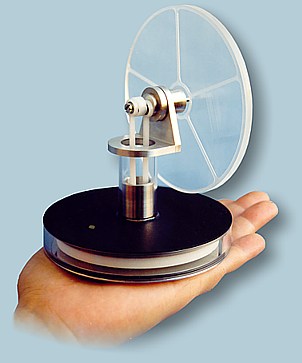|
Backround
In the family of heat engines, 'Stirling engine' defines a closed-cycle regenerative hot air engine. In this context; "hot air" may be taken to include other permanent gasses, "closed-cycle" to mean the working fluid is permanently contained within the system, and "regenerative" to refer to the use of an internal heat exchanger - the regenerator.
In the conversion of heat into mechanical work, the Stirling engine has the potential to achieve the highest efficiency of any real heat engine, theoretically up to the full Carnot efficiency, though in practice this is limited by non-ideal properties of the working gas and engine materials, such as friction, thermal conductivity, tensile strength, creep, melting point, etc. Though traditionally classified as an external combustion engine the Stirling engine can run on any heat source, including solar, chemical and nuclear. There are many possible implementations of the Stirling engine most of which fall into the category of reciprocating piston engine.
In contrast to internal combustion engines, Stirling engines have the potential to be more energy efficient, quieter, and more reliable with lower maintenance requirements. They are preferred for certain niche applications that value these unique advantages, particularly in cases where the primary objective is not to minimize the capital cost per unit power ($/kW), but rather to minimize the cost per unit energy generated by the engine ($/kWh). Compared to an internal combustion engine of a given power rating, Stirling engines currently have a higher capital cost and are usually larger and heavier; therefore, the engine technology is rarely competitive on this basis alone. For some applications, however, a proper cost-benefit analysis can favor a Stirling engine over an internal combustion engine.
In recent years, the advantages of Stirling engines have become increasingly significant, given the general rise in energy costs, energy shortages[citation needed] and environmental concerns such as climate change. These growing interests in Stirling technology have fostered the ongoing research and development of Stirling devices. The applications include water pumping, space-based astronautics, and electrical generation from plentiful energy sources that are incompatible with the internal combustion engine, such as solar energy, agricultural waste and domestic refuse.
Another useful characteristic of the Stirling engine is that the cycle is reversible. Which means that if supplied with mechanical power, it can function as a heat pump. Experiments have been performed using wind power driving a Stirling cycle heat pump for domestic heating and air conditioning. In the late 1930s, the Philips Corporation of the Netherlands successfully utilized the Stirling cycle in cryogenic applications.
|
